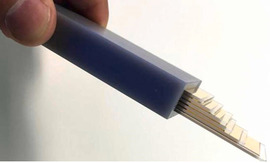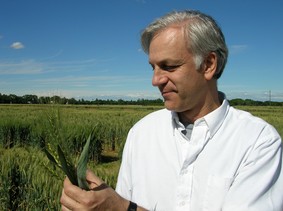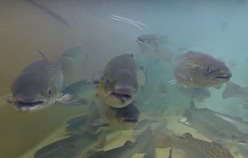|
Having trouble viewing this email? View it as a Web page.

|
|
|
Fresh from the Field is a weekly album showcasing transformative impacts made by grantees supported by the National Institute of Food and Agriculture.
Nov. 30, 2017
|
|
Success Stories

New Technology Makes Oak Wilt Detection Faster,
More Affordable
Oak
wilt fungus is an invasive plant pathogen that often goes unnoticed, until
it’s too late. Not anymore. New technology developed by University of Minnesota
(UMN) College of Food, Agricultural and Natural Resource Sciences offers a
simple, affordable diagnostic test utilizing nanotechnology and gold.
The
U.S. Forest Service estimates that some 266,000 oak trees in Minnesota were
infected by oak wilt fungus between 2007 and 2016, making oak wilt the
second greatest invasive disease threat to the state’s plants.
There
are currently only two ways to detect the disease: visually – two or three
weeks after infection onset – or with lab tests, that may take weeks to
complete and cost up to $120 per sample. UMN’s new hand-held reader can detect the disease
within 30 minutes at a cost of $5 per sample.
NIFA supports this project through Hatch funding.
Read the full story in the Echo Journal. Photo
courtesy of University of Minnesota University of Minnesota College of Food, Agricultural, and Natural Resource Sciences and Abbas Lab.
|
 NCSU Team for Methyl Bromide Helps Growers
Maintain Yields While Improving the Ozone Layer
With
the help of extension specialists at NC State University, farmers in the
Tarheel State are helping to reduce the size of the ozone hole over the South
Pole.
NC
State staff are working with farmers to incorporate integrated pest management
(IPM) strategies into their operations as they transition away from the toxic
fumigant methyl bromide, which accounts for a large portion of ozone depleting
halogens above Antarctica.
Nothing
can replace the effectiveness of methyl bromide on a one-to-one basis, but IPM
offers solutions by addressing insect, disease, and weed problems separately.
The NC State working group experimented with drip and fumigant pesticides, soil
improvement tactics, and covering the ground after planting and while
fumigating. They focused on pest management in strawberry, tomatoes, and
peppers.
Although successful
overall, results varied; drip irrigation proved effective with
tomatoes and peppers; adding mustard meal before planting helped strawberry
yield but was less effective for tomatoes; and vigorous rootstocks using
grafted tomatoes suppressed bacterial wilt, Southern stem blight, and root knot
nematodes and increased yield similar to or better than fumigants.
NIFA supports the research with a Methyl Bromide
Transition Program grant.
Read the full article in IPM in the South. Photo
courtesy of Rosemary Hallberg.
|
News Coverage

Wood Pellets Outperform Fossil Fuels, Natural
Gas in Reducing Greenhouse Gases
Researchers
at the University of New Hampshire (UNH) have found a way to cut greenhouse gas
emissions from home heating by more than 50 percent. The research team of UNH
and Spatial Informatics Group in Pleasanton, California, discovered that using
wood pellet fuel reduces greenhouse gas emissions by 54 percent vs. home
heating oil, and by 59 percent vs. natural gas.
The
findings are especially important for New York and the five New England states,
where residents account for about 88 percent of the entire U.S. consumption of
home heating oil.
NIFA supported the program through a McIntire-Stennis
grant.
Read the full article in University of New Hampshire
News. USDA photo.
|
The Library

Davis Researchers Find Genes to Resist Stem Rust
Wheat accounts for more than one fifth of the
calories and protein consumed by humans – still, production must increase to
feed the projected population of 9.7 billion by 2050. A University of California – Davis research team led
by Dr. Jorge Dubcovsky used an Agriculture and Food Research Initiative grant
to identify a gene from pasta wheat that confers resistance to the new virulent
races of the stem rust pathogen that appeared in Africa at the beginning of
this century. Their discovery may reduce yield loss and contribute to the
necessary production increases.
NIFA supports this project through an
Agriculture and Food Research Initiative grant.
Read the article online from the Proceedings of
the National Academy of Sciences. Photo courtesy of Jorge Dubcovsky.
|
Video
 Something Fishy is Going on in Maine
U.S. production of Atlantic salmon has dropped
more than 35 percent since 2000, due to an increase in the death rate of salmon
embryos. AFRI-funded research at the University of Maine shows that female
salmon with high levels of two types of hormone produce eggs that achieve an 80
percent survival rate. Researchers are now determining patterns of steroid
deposition into the eggs. Raising the salmon embryo survival rate will make fish farming more profitable and improve the economy in Maine.
NIFA supports this project with an AFRI grant.
Read the full article and watch the video at
University of Maine News to see researchers describe the project.
|
Tweet of the Week
#NIFAIMPACTS
|
|

NIFA’s mission is to invest in and advance agricultural research, education, and extension that solve societal challenges. NIFA’s investments in transformative science directly support the long-term prosperity and global preeminence of U.S. agriculture. To learn more about NIFA’s impact on agricultural sciences, visit www.nifa.usda.gov/Impacts, sign up for email updates or follow us on Twitter @USDA_NIFA, #NIFAImpacts.
Editor: Scott Elliott
USDA is an equal opportunity lender, provider, and employer.
|
|